 Christopher Otto has clearly read the twentieth century composer’s guide to nicking ideas from the East, and leans heavily on knowledge of just intonation. But this debut release isn’t one of those superficial “exotic” borrowings (when do we get to lay into Terry Riley for that, by the way?) and probably has more to do with the kind of tonal particularly of Horatiu Radulescu than any mid-twentieth century US composers.
Christopher Otto has clearly read the twentieth century composer’s guide to nicking ideas from the East, and leans heavily on knowledge of just intonation. But this debut release isn’t one of those superficial “exotic” borrowings (when do we get to lay into Terry Riley for that, by the way?) and probably has more to do with the kind of tonal particularly of Horatiu Radulescu than any mid-twentieth century US composers.
The pieces have a fairly intricate scaffolding to do with steady shifting using just intonation intervals, two string quartets moving around the interval of ragisma (in lay terms, a near-imperceptibly small interval), and a third (live) quartet kind of harmonically filling in the two. If that’s a bit beyond your music theory chops, it basically means he’s going into a harmonic world of very precise, small intervals — leaving the effect of some very wonky music.
There’s a danger in putting those descriptions front and centre that it puts people off from the music, so to be clear — this isn’t archly “difficult” music; there’s a sensuality and a sombre affection for the tonalities that belies its mathematical and theoretical underpinnings. It’s certainly a peculiar and odd sound that he produces, but if “precise just intonation intervallic variegation” sounds unbearably overwrought to you, then it kind of sounds like a dilapidated tape of a broken air raid siren underwater. The precision of the playing is quite remarkable — I hope the composer makes more details available. There’s moments where the intonation and piled-up apparent “dissonance” create effects that are less violin, more like massed brass, where a kind of composite note forms out of the aggregation of tiny differences.There’s also one of my favourite effects — that I remember from Helmut Lachenmann‘s string quartets — where shifting tones pass through different apparent dissonances, suddenly popping up with chords that sound like big euphoric major chords, then fleetingly return to an awkward hinterland of not-quite-dissonance.
It’s kind of tricky to place this in terms of compositional influence — I can certainly say that, on paper, this sits next to the kind of thoroughly researched harmonic expansion of (say) Iannis Xenakis through to spectralism, the acoustic attention-to-detail of Lachenmann, the arctic shift of Giacinto Scelsi or perhaps even the forensic detail of a sound artist like Jacob Kirkegaard. But none of those quite ring true. It’s a fascinating soundworld and deeply meditative, but it’s a lot sharper, more toothy than something you’d stick on to relax, per se.Whatever the weather, it’s a slow and achingly gorgeous sound and definitely worth killing your neighbours and cranking the stereo for.
-Kev Nickells-



